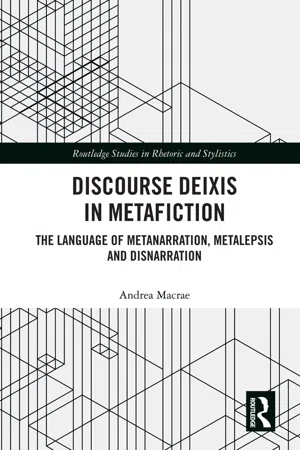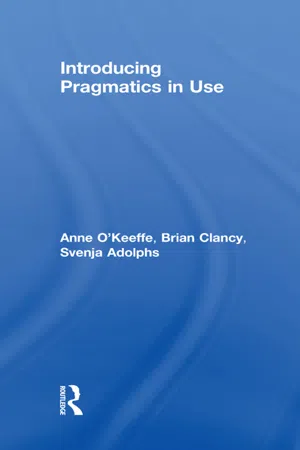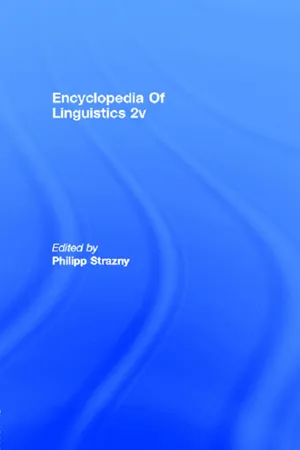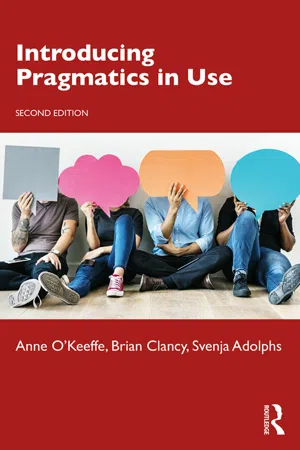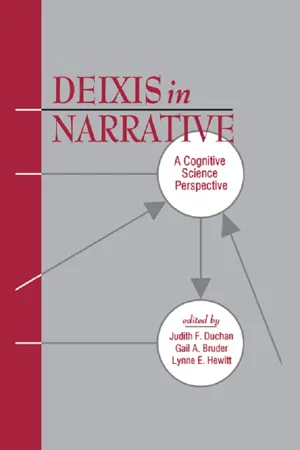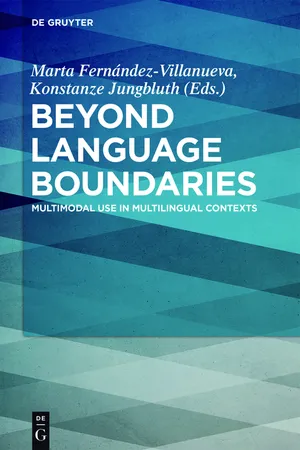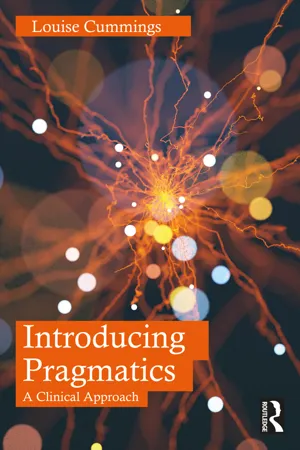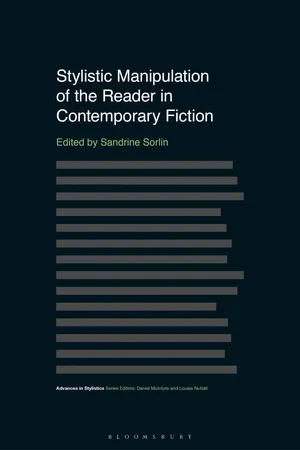Languages & Linguistics
Deictic centre
The deictic center refers to the point of reference from which spatial, temporal, and personal deixis are determined in language. It is the perspective from which the speaker or writer locates themselves and interprets the spatial and temporal relationships between objects and events. The deictic center is crucial for understanding the context and meaning of language in communication.
Written by Perlego with AI-assistance
12 Key excerpts on "Deictic centre"
Learn about this page
Index pages curate the most relevant extracts from our library of academic textbooks. They’ve been created using an in-house natural language model (NLM), each adding context and meaning to key research topics.
- eBook - ePub
Discourse Deixis in Metafiction
The Language of Metanarration, Metalepsis and Disnarration
- Andrea Macrae(Author)
- 2019(Publication Date)
- Routledge(Publisher)
Deixis im vorstellungsraum gives us one dimension of deixis in literature, then: the conceptual. In literary discourse, the Deictic centre, the elements referred to, and the deictic relations between the centre and elements are conceptual, specifically, based on imaginative invention.A second feature of deixis in literature relates to what Ehlich (1983, p. 89) calls deixis im textraum (deixis in the realm of the text). Ehlich uses this term to refer to a particular use of discourse deixis. Along with the conceptual space of the storyworld, deixis in written literature, and discourse deixis especially, involves the ‘space’ of the material written text. The Deictic centres in question here are that of the writer in the act of producing the text and that of the reader in the act of processing the text and her corresponding sequential conceptual act of imaginatively realising the text. The elements deictically referred to are units of text. Rauh describes this kind of Deictic centre asa center of orientation […] which corresponds […] to his momentary situation within the course of a text, considered either temporal or local and with respect to which either temporal or local domains of the textual context are determined. […] Establishing a center of orientation in discourse is possible because the encoding of discourse is a continuous process along which at any point the encoder may stop and establish a center of orientation. Since a continuous piece of discourse may be looked upon as having either temporal or (in writing) local extension, the fixing of temporal or local points of orientation is respectively possible. […] If a continuous piece of discourse is treated as having local extension, practically all local deictic expressions can be used. In this context their symbolic meanings are unchanged and only their indexical meanings are different, their referents not being extra-linguistic local areas but segments of discourse.(1983, pp. 48–49) - eBook - ePub
- Anne O'Keeffe, Brian Clancy, Svenja Adolphs(Authors)
- 2011(Publication Date)
- Routledge(Publisher)
3.12 , the father’s utterances reflect the close connection that he feels with his son constituted by his use of deictic expressions (see also Tannen, 2007). Although the examples used to illustrate this section are person deictic in nature, the Deictic centre is also associated with place and time deixis and this will be discussed later in the chapter.The Deictic centreLevinson (1983: 64)(1) The central person is the speaker.(2) The central time is the time at which the speaker produces the utterance.(3) The central place is the speaker’s location at utterance time.(4) The discourse centre is the point at which the speaker is currently at in the production of his [sic. ] utterance.(5) The social centre is the speaker’s social status and rank, to which the status and rank of addresses or referents is relative.3.5 BASIC CATEGORIES OF DEIXIS
Deixis is traditionally subdivided into a number of categories: person, place and time deixis are the most common of these categories. Two additional categories, discourse and social deixis, are also present in some of the most influential work done in the area (cf. Lyons, 1977; Levinson, 1983; Fillmore, 1997). There is also a sixth deictic category referred to as empathetic deixis (see Lyons, 1977).Person deixis
Person deixis is concerned with ‘the identity of the interlocutors in a communication situation’ (Fillmore, 1997: 61). Personal pronouns such as I and you are the most obvious and most frequent manifestations of person deixis. In order to illustrate the frequency and importance of these and other personal pronouns in casual conversation, frequency counts for the top 20 most frequently occurring words were generated for the Limerick Corpus of Irish English (LCIE) using Wordsmith Tools (Scott, 2009) and the results are displayed in Table 3.1 - eBook - ePub
- Philipp Strazny(Author)
- 2013(Publication Date)
- Routledge(Publisher)
Theory of language). Three main categories of deixis have been traditionally distinguished: person, time, and place. It is generally accepted that deixis is an egocentric system in that the speaker chooses his own perspective when integrating personal, temporal, and spatial information into the message: the central person is the speaker, the central time is the time at which the speaker encodes the message, and the central place is the speaker’s location at coding time.Person deixis involves the identification of the participants in the communicative situation as well as other individuals referred to in the utterance. Among the linguistic expressions that fulfill this identifying function, personal pronouns and inflectional affixes attached to nouns and verbs are the most usual ones. The basic grammatical distinctions in person deixis are the categories of first, second, and third person: the first person refers to the speaker himself, the second person refers to the addressee, whereas the third person refers to a person or persons who are part of the conversational group but who are neither the speaker nor the addressee. In addition to this contrast, person deictic items typically include information about number and gender. The singular/plural distinction is the primary number opposition in all languages. As regards gender, person deictic items may convey information about the sex (semantic gender) or arbitrary class (grammatical gender) of their referents.Place deixis deals with the specification of the spatial location of the entities referred to in the utterance. Although locations are most commonly established by reference to that of the speaker, some languages also take the addressee’s position as the central place. The basic spatial contrast in most languages, illustrated by the English pair here vs. there, is that of ‘proximal to the speaker’ and ‘distal to the speaker’. Many languages, however, exhibit a three-fold opposition; Spanish, for example, distinguishes three locative adverbs: aquí (‘near the speaker’), allí (‘far from the speaker’), and ahí (‘a little way from the speaker’). Spatial relations may be expressed linguistically by a wide range of items. The most common perhaps are locative adverbs (here/there), demonstrative pronouns (I will take that), and adjectives (this - eBook - ePub
- Anne O'Keeffe, Brian Clancy, Svenja Adolphs(Authors)
- 2019(Publication Date)
- Routledge(Publisher)
from .Task 4.4 Identifying Place DeicticsIdentify the linguistic item(s) that represent spatial/locational deixis in extract 4.10.(4.10)In many languages there exists a fundamental distinction between proximal (or relatively close to the speaker) and distal (non-proximal, sometimes relatively close to the addressee) deictic expressions of place (Diessel, 1999; Levinson, 2004). For example, here and there are crucially tied to the deictic field of the speaker, and the addressee(s) determines the spatial coordinates of the utterance in order to assign meaning. The extent to which context is involved in determining the reference of here is evident in the interaction in extract 4.11 between participants in a biochemistry study group in the MICASE corpus.(4.11)In this extract the participants are discussing whether or not it is important to know the names of certain enzymes. <$3> uses here to here to point to a specific part of a chemical formula that appears to be written down somewhere in the shared immediate context. We have, of course, already encountered the phenomenon of place deixis previously in this chapter in extract 4.4 when we looked at <$3>’s repeated use of down there .Time deixis
According to Huang (2007: 144), time deixis ‘is concerned with the encoding of temporal points and spans relative to the time at which the utterance is produced’. In other words, in order to correctly interpret a time deictic, it needs to be considered in relation to the time at which the communicative act takes place. To do this correctly, we need to distinguish between coding time (CT), the moment of the utterance, and receiving time (RT), the moment of reception. Coding time is usually located around the speaker, whereas receiving time is located around the addressee. Usually, because the majority of conversation is face-to-face in nature, CT and RT are considered to be identical. However, there are situations where CT and RT are different, and this can lead to a situation where the utterance becomes unanchored (see Fillmore, 1997: 60). For example, Fillmore suggests a ‘worst case scenario’ for an ‘unanchored’ sentence: finding a message in a bottle which says Meet me here at noon tomorrow with a stick about this big . Notions of time deixis are expressed using both simple adverbs of time, such as now, then, today, tomorrow, yesterday , and complex adverbs of time, such as this month, next year or last week . Similar to place deixis, time deixis also distinguishes between a proximal time now (time ‘around now’ including the CT) and a distal time then - eBook - ePub
Deixis in Narrative
A Cognitive Science Perspective
- Judith F. Duchan, Gail A. Bruder, Lynne E. Hewitt, Judith F. Duchan, Gail A. Bruder, Lynne E. Hewitt(Authors)
- 2012(Publication Date)
- Psychology Press(Publisher)
deictics (Bühler). By these terms, they designate those words and aspects of language that can only be understood with reference to a NOW, a HERE, and an I. For some, the irreducible deictic word is THIS, which can refer to anything at all, depending on the particulars of the speech situation. “This time” is NOW, “this place” is HERE, and “this person” is I.Deixis (adjectival form, deictic) is a psycholinguistic term for those aspects of meaning associated with self-world orientation. Deixis is a language universal (Hockett, 1963 ) that orients the use of language with respect to a particular time, place, and person. Karl Bühler, the Austrian psychologist and semiotician, was the first person to employ the term in its modem sense. He distinguished the deictic field (Zeigfeld) of language from its symbolic field, and named the orientational axes of the deictic field the Origo of Here/Now/I:Two intersecting perpendicular strokes on the page can serve as a coordinate system for us with O as the origo, the point of origin for the coordinates:I maintain that three deictic words must be put at the place of O, if this scheme is to represent the deictic field of human language, namely the deictic words here, now, and I. These lexical items, so simple in their sound structure, might induce the language theorist into philosophical abysses or to respectful silence, when challenged to determine their function. Rather, he should simply acknowledge that it is certainly very peculiar, but nevertheless precisely statable, how they function in a concrete utterance…. In the sound form, in the phonetic pattern of the words now, here, I - eBook - ePub
- Gunter Senft(Author)
- 2014(Publication Date)
- Routledge(Publisher)
2Pragmatics and psychology Deictic reference and gesture2.1 INTRODUCTION
How do speakers of different languages refer to objects, persons, animals, places, periods of time and even texts or text passages? When speakers make these so-called ‘deictic’ references, they communicate in certain – linguistic and non-linguistic – contexts, and these contexts influence the shape of our utterances. Natural languages are context-bound – and it is deixis that ‘concerns the ways in which languages encode or grammaticalize features of the context of utterance or speech event , and thus also concerns ways in which the interpretation of utterances depends on the analysis of that context of utterance’ (Levinson 1983: 54; see also Senft 2004a: 1). This contextdependence of linguistic reference is known as ‘indexicality’ and it is taken by philosophers such as Hilary Putnam (1975: 187; see also 193) as a ‘constitutive feature of human language’ and a general characteristic of language and interaction. Indexicality can broadly be defined as ‘the study of expressions relying on the context of use to select items of discourse’ (Corazza 2010: 1).In the first part of this chapter, the phenomenon of deixis is presented and discussed. The historically most influential contribution on the topic of deixis was presented by the German psychologist Karl Bühler (1879–1963) in his by now classic work Sprachtheorie: Die Darstellungsfunktion der Sprache (Theory of Language: The representational function of language - eBook - ePub
- Sebastian Loebner(Author)
- 2013(Publication Date)
- Routledge(Publisher)
deixis.The use of deictic expressions not only anchors an utterance in the world, it also imposes the perspective of the speaker on the utterance. The speaker forms the so-called Deictic centre; the ‘I’ is the one who decides who is being addressed; where the speaker is is ‘here’; when they speak is ‘now’. In the first part of this chapter, we will consider the three most important deictic relations: relation to the persons involved in the utterance (4.1 ), to the spatial situation (4.2 ) and to the time of utterance (4.3 ).4.1 PERSON DEIXISPerson deixis is deixis based on the linguistic category of person. The category of person relates to the roles that the participants take in an individual utterance: in the singular, the ‘1st person’ is the speaker, or producer, of the utterance, S for short; the ‘2nd person’ is the addressee,2 or A; the term ‘3rd person’ subsumes everybody who is neither first nor 2nd person.3 These roles are called discourse roles. In most languages the discourse roles play a role in grammar; these are languages that have the category of ‘grammatical person’. English is one of these languages: grammatical person plays a role in the choice of personal pronouns and the forms of fnite verbs (she says;I am;you are; etc.).The most salient linguistic means of person deixis are systems of personal pronouns. They may differ in the grammatical categories of person, gender, number and formality. Table 4.1 displays the personal pronouns in German. They form a paradigm, i.e. a closed system in which each slot is filled with a particular form. It often happens that there is the same form for more than one slot (this is known as syncretism) as is the case for the form sie/Sie in the German paradigm: sie is both 3rd person feminine singular (‘she’) and 3rd person plural (‘they’); Sie (with capital S ) is the 2nd person pronoun of formal address (recall the discussion in 2.3.1 - eBook - ePub
- Marta Fernández-Villanueva, Konstanze Jungbluth, Marta Fernández-Villanueva, Konstanze Jungbluth(Authors)
- 2016(Publication Date)
- De Gruyter(Publisher)
Soziolinguistik und Sprachgeschichte: Querverbindungen. Brigitte Schlieben-Lange zum 50. Geburtstag von ihren Schülerinnen und Schülern überreicht , 209–228. Tübingen: Narr.Passage contains an image Federica Da Milano, Università degli Studi di Milano-Bicocca
Deictic Strategies as Expression of Identity
Abstract: This contribution investigates the expression of personal deixis, often intertwined with two other aspects of deixis, namely spatial and temporal deixis, in two case-studies. Deictics are those linguistic forms whose interpretation essentially requires reference to some elements of the situation in which they are produced. As far as person reference is concerned, the act of referring to another individual leads us straight to the core of multimodal interaction: it is the first indicator of an individual cultural identity.The case-studies are represented by the utterances of Catalans living in Spain and by the narratives (life stories) of immigrants of different origins in Italy.Keywords: deixis, identity, person reference, personal pronouns, demonstratives“I is perhaps the most important and the least understoodof our everyday (every minute) expressions .This is a bizarre situation, a constant source of deep philosophical confusion ,and it calls urgently for treatment .”(M. de Gaynesford, I: the meaning of the first person term )1Introduction
Deictics are those linguistic forms whose interpretation essentially requires reference to some elements of the situation in which they are produced. As suggested by Lyons, “by deixis is meant the location and identification of persons, objects, events, processes and activities being talked about [. . .] in relation to the spatiotemporal context created [. . .] by the act of utterance and the participation in it, typically, of a single speaker and at least one addressee” (Lyons 1977: 637). As far as person reference is concerned, the act of referring to another individual leads us straight to the core of multimodal interaction: it is the first indicator of an individual cultural identity. Person reference is a subject that stands at a central intersection between various behavioural sciences, such as linguistics, sociology, psychology and philosophy. However, the empirical study of person reference in natural conversation has been curiously neglected, particularly from a cross-cultural perspective that might throw much needed light on the relation between culture, social structure and language use. - eBook - ePub
- Salvatore Attardo, Lucy Pickering(Authors)
- 2021(Publication Date)
- Wiley-Blackwell(Publisher)
Temporal deixis is based, in Western cultures, on a metaphorical vector (geometrically, a line with a direction): the past is behind us and the future is ahead. However, in Aymara, the past is in front of us (since it is known) and the future is behind (since we don’t know what will come) (Núñez & Sweetser, 2006).Summing up, Western culture conceptualizes spatio-temporal deixis as two distinct axes, a temporal past–present–future vector, and a spatial proximal/distal opposition. At the intersection of these two axes lies the deictic center, the speaker, in the here and now.7.2.2 Discourse Deixis
Discourse deixis is essentially a transference of spatio-temporal deixis onto speech and/or writing. Thus, we can refer to “this sentence” meaning the present one, or to “that sentence” meaning another one uttered at a prior time. Likewise, we can refer to the “previous” unit of discourse (sentence, paragraph, section, etc.) or the “next.”Some interesting further refinements are the pair “former/latter,” used primarily in formal language, which indicate the first and second of two possible referents present in the domain selected. “Respectively” is also an interesting deictic marker which indicates that two prior referents are pair-wise related to two new ones:(113) The national tour of the Tony-nominated Peter Morgan play Frost/Nixon – co-starring Stacy Keach and Alan Cox as, respectively, disgraced former President Richard Nixon and TV talk-show host David Frost – kicks off Sept. 30 in Des Moines, IA. http://www.playbill.com/article/frost-nixon-tour-with-keach-and-cox-launches-sept-30-com-153761Thus, Stacy Keach plays Nixon and Alan Cox plays David Frost.7.2.3 Social Deixis
Social deixis is defined as the linguistic features that “reflect or establish or are determined” by the social situation in which the utterance occurs (Fillmore, 1971/1997, p. 112). This pellucid definition has the advantage of highlighting the dialectical relationship between social situation and language: social deixis is both reflected and determined by the social environment in which it occurs. In other words, the causality goes both ways. - eBook - ePub
Introducing Pragmatics
A Clinical Approach
- Louise Cummings(Author)
- 2023(Publication Date)
- Routledge(Publisher)
4 DeixisDOI: 10.4324/9781003177562-5Learning objectives: By the end of this chapter, you will:- Understand how certain linguistic expressions can be used to ‘point to’ or ‘pick out’ entities in the context of an utterance. The lexical items that encode context in this way are indexical and their function is one of deixis.
- Appreciate that a wide range of words are indexical in this way, including demonstratives (e.g. that), adverbs (e.g. there), adjectives (e.g. last week), and pronouns (e.g. you).
- Reliably identify five categories of deixis: person deixis, social deixis, time deixis, place deixis, and discourse deixis.
- Understand that some expressions can function as more than one form of deixis such as the demonstrative in I walk home this way (place deixis) and I fly to Rome this week (time deixis).
- Be aware that while deictic expressions look to context for reference, anaphoric expressions look to an antecedent within the utterance for reference.
- Appreciate that it can be difficult to establish in specific cases if an expression has a deictic function or an anaphoric function.
4.1 Introduction
You are walking through a market in town, and you overhear a stall owner saying to a customer What did you think of that? You continue walking through the market, and you pass two friends who are taking leave of each other. One says to the other I will meet you there tomorrow. As you wait at the bus stop, an elderly woman asks you What time is the next bus to the city centre? These utterances are representative of the hundreds that we use and hear every day that contain ‘pointing’ words. These are expressions like I, you, there, tomorrow, and that where we must look to the extralinguistic context of the utterance to establish the referents of these terms – semantic elements alone will not suffice to ‘pick out’ the referents. Because you are physically present when these utterances are spoken, you know the referents of the expressions you, I, tomorrow, and next bus. Your presence at each of these speech events allows you to determine that the pronoun you refers to the customer, and I refers to one of the two friends who are saying goodbye to each other. Meanwhile, tomorrow refers to an upcoming 24-hour period, and next bus refers to the bus for the city centre that will arrive after a particular point in time. But even from your unique vantage point, you are still not able to determine what the stall owner is referring to when he uses the demonstrative pronoun that, or the location that the friend refers to by means of the adverb there - Sandrine Sorlin(Author)
- 2019(Publication Date)
- Bloomsbury Academic(Publisher)
This survey of theory of social deixis illustrates a range of thinking. Within the work discussed here, social deixis is conceptualized both narrowly and widely. It is conceived of more narrowly in two ways: in terms of ‘empathetic’ or ‘emotional’ use of demonstratives and articles or in terms of ‘social’ or ‘relational’ use of honorific address. It is conceived of more widely in two ways, too, both under subheadings of more ‘social’ or ‘relational’ uses: including modality and evaluative language or including replacement vocabularies. The wider accounts evoke three questions. First, what is the nature of the Deictic centre, and the deictic relationships, in modality, evaluative language and replacement vocabularies? Secondly, given the scope of evaluative language and replacement vocabularies, what, then, can be excluded from deixis as a category of language? Thirdly, what range or remit of social deixis, within that which has been discussed, is useful or relevant for analysis of the workings of deixis in literature, specifically?What happens if we scale the concept of deixis back, and argue that modality, evaluative language and replacement vocabularies are not socially deictic, or at least not in the same sense as demonstratives, articles and terms of address? This argument can be made on two counts: an identifiable or implicit Deictic centre seems less apparent in or essential to the workings of modality, evaluative language and replacement vocabularies and modality, evaluative language and replacement vocabularies do not seem to construct a relationship between speaker and referent, and/or between speaker and addressee, in the same sense as person, spatial and temporal deixis.This would leave us with a smaller set of terms within social deixis, the function of which could possibly then be usefully divided into two subtypes: (1) attitudinal-experiential deixis and (2) socio-relational deixis . Attitudinal-experiential deixis would include the use of the determiners ‘this’, ‘that’, ‘these’, ‘those’, and the articles ‘the’ and ‘a’ (and feasibly also ‘one’). Socio-relational deixis would include the use of terms of address (e.g. ‘your ladyship’) and related terms of reference (e.g. ‘her ladyship’) and titular and pronominal markers of relative social status or social or familial relationships. Notably, determiners, articles and terms of address have all been included within the category of person deixis in some accounts (e.g. Lyons 1977- eBook - ePub
Crosslinguistic Approaches to the Psychology of Language
Research in the Tradition of Dan Isaac Slobin
- Jiansheng Guo, Elena Lieven, Nancy Budwig, Susan Ervin-Tripp, Keiko Nakamura, Seyda Ozcaliskan, Jiansheng Guo, Elena Lieven, Nancy Budwig, Susan Ervin-Tripp, Keiko Nakamura, Seyda Ozcaliskan(Authors)
- 2010(Publication Date)
- Psychology Press(Publisher)
In assessing the role of ‘thinking for speaking’ it is important to bear the bigger picture, beyond the facts presented in this chapter, in mind. A striking part of the bigger picture is that, as mentioned, the patterns of conception evoked by ‘thinking for speaking’ have a persistence outside the “evanescent time frame of constructing utterances” (Slobin, 1996, p. 76). Adult spatial memory, when tested in non-linguistic tasks, matches the conception required by their language in a stable way (Levinson, 2003). In this particular domain, then, where we find cultural cognitive diversity and the cognition covarying with the language, ‘thinking for speaking’ may be too weak a mechanism to predict the cognitive effects outside a language task (in fact, Slobin has always been careful to distance himself from stronger Whorfian claims). If we put this together with the findings in this chapter, we may need a rather different kind of explanation, a matter we return to in the conclusions.Before getting down to details, some preliminaries need to be explained. First, some terminology. We have argued elsewhere that there are distinct subdomains of spatial conception, notably deixis, topology, and frames of reference (Levinson, 2003). Deictic discriminations are basically about distance from ego (as in ‘this’ vs. ‘that’), or direction to or from ego (as in ‘coming’ vs. ‘going’).2 They give radial characterizations, not vector directions (you can ‘come here’ from any direction). Topological distinctions are essentially concerned with relations of contact, containment, or propinquity between a thematic object or ‘figure’ and a landmark object or ‘ground.’ Frame of reference distinctions involve the larger spatial framework which allows us to determine the direction of one object with respect to another one separated in space. Frames of reference are thus essentially coordinate systems, which in human cognition are nearly always polar coordinates. Investigation shows that languages use just three main frames of reference (Levinson, 2003): intrinsic relations which use the intrinsic facets of the landmark object to extract a direction (as in ‘at the back of the post office’), relative relations which use our bodily coordinates and express directions in terms of left, right, front, and back, and finally absolute
